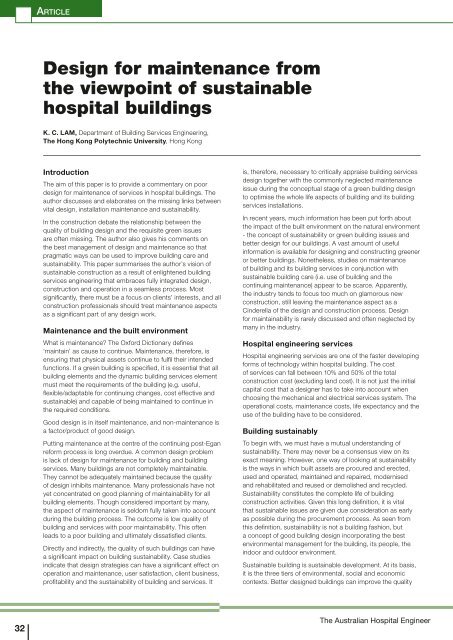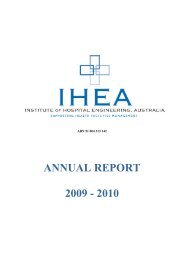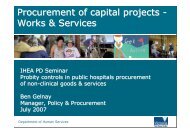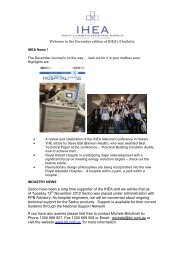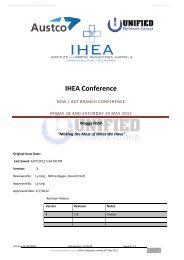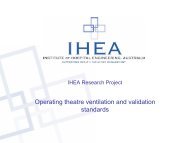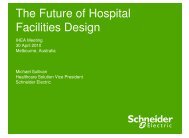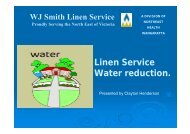Design for maintenance from the viewpoint of sustainable hospital ...
Design for maintenance from the viewpoint of sustainable hospital ...
Design for maintenance from the viewpoint of sustainable hospital ...
You also want an ePaper? Increase the reach of your titles
YUMPU automatically turns print PDFs into web optimized ePapers that Google loves.
Ar t i cl e<br />
<strong>Design</strong> <strong>for</strong> <strong>maintenance</strong> <strong>from</strong><br />
<strong>the</strong> <strong>viewpoint</strong> <strong>of</strong> <strong>sustainable</strong><br />
<strong>hospital</strong> buildings<br />
K. C. LAM, Department <strong>of</strong> Building Services Engineering,<br />
The Hong Kong Polytechnic University, Hong Kong<br />
Introduction<br />
The aim <strong>of</strong> this paper is to provide a commentary on poor<br />
design <strong>for</strong> <strong>maintenance</strong> <strong>of</strong> services in <strong>hospital</strong> buildings. The<br />
author discusses and elaborates on <strong>the</strong> missing links between<br />
vital design, installation <strong>maintenance</strong> and sustainability.<br />
In <strong>the</strong> construction debate <strong>the</strong> relationship between <strong>the</strong><br />
quality <strong>of</strong> building design and <strong>the</strong> requisite green issues<br />
are <strong>of</strong>ten missing. The author also gives his comments on<br />
<strong>the</strong> best management <strong>of</strong> design and <strong>maintenance</strong> so that<br />
pragmatic ways can be used to improve building care and<br />
sustainability. This paper summarises <strong>the</strong> author’s vision <strong>of</strong><br />
<strong>sustainable</strong> construction as a result <strong>of</strong> enlightened building<br />
services engineering that embraces fully integrated design,<br />
construction and operation in a seamless process. Most<br />
significantly, <strong>the</strong>re must be a focus on clients’ interests, and all<br />
construction pr<strong>of</strong>essionals should treat <strong>maintenance</strong> aspects<br />
as a significant part <strong>of</strong> any design work.<br />
Maintenance and <strong>the</strong> built environment<br />
What is <strong>maintenance</strong>? The Ox<strong>for</strong>d Dictionary defines<br />
‘maintain’ as cause to continue. Maintenance, <strong>the</strong>re<strong>for</strong>e, is<br />
ensuring that physical assets continue to fulfil <strong>the</strong>ir intended<br />
functions. If a green building is specified, it is essential that all<br />
building elements and <strong>the</strong> dynamic building services element<br />
must meet <strong>the</strong> requirements <strong>of</strong> <strong>the</strong> building (e.g. useful,<br />
flexible/adaptable <strong>for</strong> continuing changes, cost effective and<br />
<strong>sustainable</strong>) and capable <strong>of</strong> being maintained to continue in<br />
<strong>the</strong> required conditions.<br />
Good design is in itself <strong>maintenance</strong>, and non-<strong>maintenance</strong> is<br />
a factor/product <strong>of</strong> good design.<br />
Putting <strong>maintenance</strong> at <strong>the</strong> centre <strong>of</strong> <strong>the</strong> continuing post-Egan<br />
re<strong>for</strong>m process is long overdue. A common design problem<br />
is lack <strong>of</strong> design <strong>for</strong> <strong>maintenance</strong> <strong>for</strong> building and building<br />
services. Many buildings are not completely maintainable.<br />
They cannot be adequately maintained because <strong>the</strong> quality<br />
<strong>of</strong> design inhibits <strong>maintenance</strong>. Many pr<strong>of</strong>essionals have not<br />
yet concentrated on good planning <strong>of</strong> maintainability <strong>for</strong> all<br />
building elements. Though considered important by many,<br />
<strong>the</strong> aspect <strong>of</strong> <strong>maintenance</strong> is seldom fully taken into account<br />
during <strong>the</strong> building process. The outcome is low quality <strong>of</strong><br />
building and services with poor maintainability. This <strong>of</strong>ten<br />
leads to a poor building and ultimately dissatisfied clients.<br />
Directly and indirectly, <strong>the</strong> quality <strong>of</strong> such buildings can have<br />
a significant impact on building sustainability. Case studies<br />
indicate that design strategies can have a significant effect on<br />
operation and <strong>maintenance</strong>, user satisfaction, client business,<br />
pr<strong>of</strong>itability and <strong>the</strong> sustainability <strong>of</strong> building and services. It<br />
is, <strong>the</strong>re<strong>for</strong>e, necessary to critically appraise building services<br />
design toge<strong>the</strong>r with <strong>the</strong> commonly neglected <strong>maintenance</strong><br />
issue during <strong>the</strong> conceptual stage <strong>of</strong> a green building design<br />
to optimise <strong>the</strong> whole life aspects <strong>of</strong> building and its building<br />
services installations.<br />
In recent years, much in<strong>for</strong>mation has been put <strong>for</strong>th about<br />
<strong>the</strong> impact <strong>of</strong> <strong>the</strong> built environment on <strong>the</strong> natural environment<br />
- <strong>the</strong> concept <strong>of</strong> sustainability or green building issues and<br />
better design <strong>for</strong> our buildings. A vast amount <strong>of</strong> useful<br />
in<strong>for</strong>mation is available <strong>for</strong> designing and constructing greener<br />
or better buildings. None<strong>the</strong>less, studies on <strong>maintenance</strong><br />
<strong>of</strong> building and its building services in conjunction with<br />
<strong>sustainable</strong> building care (i.e. use <strong>of</strong> building and <strong>the</strong><br />
continuing <strong>maintenance</strong>) appear to be scarce. Apparently,<br />
<strong>the</strong> industry tends to focus too much on glamorous new<br />
construction, still leaving <strong>the</strong> <strong>maintenance</strong> aspect as a<br />
Cinderella <strong>of</strong> <strong>the</strong> design and construction process. <strong>Design</strong><br />
<strong>for</strong> maintainability is rarely discussed and <strong>of</strong>ten neglected by<br />
many in <strong>the</strong> industry.<br />
Hospital engineering services<br />
Hospital engineering services are one <strong>of</strong> <strong>the</strong> faster developing<br />
<strong>for</strong>ms <strong>of</strong> technology within <strong>hospital</strong> building. The cost<br />
<strong>of</strong> services can fall between 10% and 50% <strong>of</strong> <strong>the</strong> total<br />
construction cost (excluding land cost). It is not just <strong>the</strong> initial<br />
capital cost that a designer has to take into account when<br />
choosing <strong>the</strong> mechanical and electrical services system. The<br />
operational costs, <strong>maintenance</strong> costs, life expectancy and <strong>the</strong><br />
use <strong>of</strong> <strong>the</strong> building have to be considered.<br />
Building sustainably<br />
To begin with, we must have a mutual understanding <strong>of</strong><br />
sustainability. There may never be a consensus view on its<br />
exact meaning. However, one way <strong>of</strong> looking at sustainability<br />
is <strong>the</strong> ways in which built assets are procured and erected,<br />
used and operated, maintained and repaired, modernised<br />
and rehabilitated and reused or demolished and recycled.<br />
Sustainability constitutes <strong>the</strong> complete life <strong>of</strong> building<br />
construction activities. Given this long definition, it is vital<br />
that <strong>sustainable</strong> issues are given due consideration as early<br />
as possible during <strong>the</strong> procurement process. As seen <strong>from</strong><br />
this definition, sustainability is not a building fashion, but<br />
a concept <strong>of</strong> good building design incorporating <strong>the</strong> best<br />
environmental management <strong>for</strong> <strong>the</strong> building, its people, <strong>the</strong><br />
indoor and outdoor environment.<br />
Sustainable building is <strong>sustainable</strong> development. At its basis,<br />
it is <strong>the</strong> three tiers <strong>of</strong> environmental, social and economic<br />
contexts. Better designed buildings can improve <strong>the</strong> quality<br />
32<br />
The Australian Hospital Engineer
Ar t i cl e<br />
<strong>of</strong> life. It has been demonstrated that sensible <strong>sustainable</strong><br />
development reduces operating cost while providing better<br />
buildings that enjoy greater occupant satisfaction and that<br />
<strong>the</strong> designers (i.e. specialists <strong>of</strong> design and operation) had a<br />
crucial role to pay in developing appropriate sustainability.<br />
Some designers may address energy consumption<br />
and <strong>the</strong> environment without giving due consideration<br />
to issues such as reducing design margins, minimising<br />
redundancy, simplification <strong>of</strong> complex designs or improving<br />
standardisation. These can all have a far greater long term<br />
impact on sustainability over <strong>the</strong> average life <strong>of</strong> a building.<br />
Hence, <strong>the</strong> building services engineer has considerable<br />
influence on <strong>the</strong> environmental per<strong>for</strong>mance <strong>of</strong> buildings<br />
through involvement in design and operation.<br />
Sustainable building care<br />
‘Green’ has been recognised as a social and political term but<br />
‘green’ also means that a function should be both human and<br />
environmentally friendly. There is a growing awareness <strong>of</strong> <strong>the</strong><br />
connection between good design and <strong>maintenance</strong> and <strong>the</strong><br />
green issues.<br />
Building care is a part <strong>of</strong> <strong>the</strong> sustainability issue. Building care<br />
is customer focused, and encompasses <strong>the</strong> management and<br />
<strong>maintenance</strong> <strong>of</strong> premises and its building services. The quality<br />
<strong>of</strong> <strong>maintenance</strong> or building care will have a significant impact<br />
on <strong>the</strong> delivery <strong>of</strong> appropriate sustainability per<strong>for</strong>mance <strong>of</strong><br />
a building. Obviously, to attain <strong>the</strong> highest building care and<br />
<strong>the</strong> best sustainability, <strong>the</strong> most effective way is to design<br />
<strong>maintenance</strong> in conjunction with <strong>the</strong> development <strong>of</strong> a green<br />
building during <strong>the</strong> outset <strong>of</strong> a project.<br />
possible; one presupposes and requires <strong>the</strong> o<strong>the</strong>r. In <strong>the</strong>ory,<br />
while zero <strong>maintenance</strong> may be striven <strong>for</strong>, it is ultimately<br />
unachievable in practice. Some <strong>maintenance</strong> will be<br />
necessary and, indeed, desirable, if one wants to ensure <strong>the</strong><br />
highest per<strong>for</strong>mance and reliability <strong>of</strong> <strong>the</strong> building systems.<br />
In good design, a minimum <strong>maintenance</strong> model in which<br />
<strong>the</strong> design <strong>of</strong> <strong>maintenance</strong> is based on good engineering<br />
principles could include:<br />
• simple design,<br />
• functional analysis,<br />
• reliability centred <strong>maintenance</strong>,<br />
• fault analysis and risk identification,<br />
• optimising operation and <strong>maintenance</strong><br />
• a combination <strong>of</strong> all planned <strong>maintenance</strong> techniques<br />
and systems<br />
If a building is to be <strong>sustainable</strong>, it is essential <strong>the</strong> services<br />
are capable <strong>of</strong> being maintained to continue in <strong>the</strong> green<br />
per<strong>for</strong>mance conditions. Issues such as selection <strong>of</strong> materials,<br />
processes, systems, effective and efficient plant operation,<br />
maintainability, standardisation, durability, health and<br />
safety – all are (in addition to energy efficiency environment<br />
issues, waste reduction etc) significant components <strong>of</strong> <strong>the</strong><br />
sustainability debate. They are whole life issues that need to<br />
be in <strong>the</strong> right context at <strong>the</strong> design stage.<br />
Considerable emphasis has been placed on close<br />
coordination between members <strong>of</strong> a project team, all seeking<br />
mutually acceptable solutions to <strong>the</strong> green design challenge<br />
and <strong>maintenance</strong> issue. It will take practical and innovative as<br />
well as synergistic designs that cut across design disciplines<br />
to achieve true success and high quality). This will result in a<br />
more <strong>sustainable</strong> building that achieves high per<strong>for</strong>mance,<br />
over <strong>the</strong> full life-cycle, in <strong>the</strong> following areas:<br />
• Lean design with appropriate technologies<br />
• <strong>Design</strong> attuned to use <strong>of</strong> building<br />
• Higher sustainability in terms <strong>of</strong> energy air/water pollution<br />
and use <strong>of</strong> resources<br />
• Low <strong>maintenance</strong> but higher reliability, durability,<br />
adaptability, availability and longer useful working life<br />
• Low obsolescence and high reusability<br />
The maximum value <strong>of</strong> <strong>sustainable</strong> building care is obtained<br />
by considering <strong>the</strong> areas stated above at all stages <strong>of</strong> a<br />
project. Sustainability needs to be considered in design and<br />
construction and in use. Spending time in researching and<br />
considering different solutions at <strong>the</strong> design stage has <strong>the</strong><br />
greatest impact on achieving a <strong>sustainable</strong> building. Time well<br />
spent in preparation and design will enhance <strong>the</strong> effectiveness<br />
and efficiency <strong>of</strong> a <strong>sustainable</strong> project. <strong>Design</strong>ing better<br />
buildings means more efficient construction techniques<br />
along with better building services. This will lead to improved<br />
<strong>maintenance</strong> and operation <strong>of</strong> <strong>the</strong> existing building stock<br />
which can bring economic, social and environmental benefits.<br />
A <strong>sustainable</strong> building and <strong>sustainable</strong> <strong>maintenance</strong> are<br />
Volume 30 - No.1<br />
33
Ar t i cl e<br />
Building services design<br />
incorporating <strong>maintenance</strong><br />
The intensification <strong>of</strong> building services installations and <strong>the</strong><br />
increased use <strong>of</strong> modern technology has resulted in modern<br />
<strong>hospital</strong>s being one <strong>of</strong> <strong>the</strong> most complex <strong>of</strong> present day<br />
building types. It is important, <strong>the</strong>re<strong>for</strong>e, that <strong>the</strong> subject <strong>of</strong><br />
<strong>maintenance</strong> needs to be addressed much sooner in <strong>the</strong><br />
design stage to ensure that <strong>the</strong> design <strong>of</strong> proper <strong>maintenance</strong><br />
is fully integrated into a building design.<br />
The implications <strong>of</strong> building services installations on <strong>hospital</strong><br />
design are many and varied with <strong>the</strong>ir inter-relationships<br />
complex. These implications not only influence <strong>the</strong> planning<br />
process <strong>of</strong> design but in many instances actually dictate <strong>the</strong><br />
planning (not just two-dimensional, but three-dimensional<br />
considerations <strong>for</strong> <strong>the</strong> accommodation <strong>of</strong> services, etc.). The<br />
implications <strong>of</strong> building services permeates throughout every<br />
aspect <strong>of</strong> <strong>hospital</strong> design so that <strong>the</strong> resulting whole becomes<br />
an integrated matrix <strong>of</strong> building fabric and building services<br />
with elements interdependent on each o<strong>the</strong>r <strong>for</strong> function,<br />
support, protection, operation and <strong>maintenance</strong>.<br />
The effect <strong>of</strong> <strong>the</strong> building services design not only<br />
encompasses <strong>the</strong> consideration <strong>of</strong> simply containing<br />
<strong>the</strong> various services, but also <strong>the</strong> parallel effects <strong>of</strong> <strong>the</strong><br />
construction method, accommodation <strong>of</strong> services and <strong>the</strong><br />
future <strong>maintenance</strong> needs. All in all, <strong>hospital</strong> design and<br />
building services are one which cannot be separated or<br />
considered in individual categories, and without team ef<strong>for</strong>t,<br />
it is impossible to produce a useful, flexible and <strong>sustainable</strong><br />
<strong>hospital</strong>.<br />
The <strong>hospital</strong> services designer has a range <strong>of</strong> equipment<br />
<strong>from</strong> which to select, can dictate how it will be installed and<br />
how <strong>the</strong> components will be brought toge<strong>the</strong>r to <strong>for</strong>m <strong>the</strong><br />
various systems to produce a functioning building. A multidisciplined<br />
design team has pr<strong>of</strong>essional responsibility to<br />
design out <strong>maintenance</strong> and/or make suitable provisions <strong>for</strong><br />
<strong>maintenance</strong>. The building services designer should have a<br />
higher pr<strong>of</strong>essional responsibility to influence <strong>the</strong> remainder<br />
<strong>of</strong> <strong>the</strong> team in <strong>the</strong> decision making process in relation to<br />
<strong>the</strong> neglected <strong>maintenance</strong> <strong>of</strong> services after <strong>the</strong>ir physical<br />
installation. Clearly, <strong>the</strong> design process can have <strong>the</strong> single<br />
largest impact on <strong>sustainable</strong> development. Cutting back on<br />
<strong>the</strong> time and resources required <strong>for</strong> a good design is a recipe<br />
<strong>for</strong> delivering poor quality outcomes.<br />
<strong>Design</strong>ing sustainability in a project life<br />
In <strong>the</strong> construction industry, many design engineers design<br />
<strong>the</strong> building services systems, supervise <strong>the</strong> installations<br />
and handover to <strong>the</strong>ir clients, wash <strong>the</strong>ir hands and leave <strong>the</strong><br />
operation and <strong>maintenance</strong> (O&M) staff to suffer <strong>the</strong> rest <strong>of</strong><br />
<strong>the</strong> 50 years. Some building services design engineers are<br />
too keen to apply available technology without due regard to<br />
<strong>the</strong> required provisions <strong>for</strong> <strong>maintenance</strong> and O&M staff have<br />
little chance to participate in <strong>the</strong> design stage. On <strong>the</strong> o<strong>the</strong>r<br />
hand, <strong>the</strong> know-how in industrial plant O&M is not adequately<br />
applied in buildings. The following sections highlight some<br />
important issues <strong>for</strong> consideration when contemplating <strong>the</strong><br />
design <strong>of</strong> a <strong>sustainable</strong> building.<br />
Control <strong>of</strong> <strong>maintenance</strong><br />
The primary consideration <strong>of</strong> a building design is <strong>the</strong><br />
production <strong>of</strong> a functional facility. Since <strong>the</strong> functional<br />
requirement drives <strong>the</strong> design, <strong>the</strong>re is a tendency to<br />
concentrate on this aspect <strong>of</strong> <strong>the</strong> design at <strong>the</strong> expense <strong>of</strong><br />
o<strong>the</strong>r considerations, especially <strong>maintenance</strong> as <strong>the</strong> last thing<br />
on <strong>the</strong> designer’s mind. However, <strong>the</strong> conceptual phase <strong>of</strong> a<br />
design is <strong>the</strong> single point in time at which <strong>the</strong>re is control over<br />
<strong>the</strong> future <strong>maintenance</strong> and operating cost <strong>of</strong> <strong>the</strong> facility. The<br />
ability to control or modify <strong>maintenance</strong> diminishes <strong>from</strong> <strong>the</strong><br />
earliest step in <strong>the</strong> design process as shown in table below.<br />
Important consideration <strong>for</strong> good <strong>maintenance</strong><br />
Problems <strong>of</strong> <strong>maintenance</strong> will result in high cost penalties<br />
including loss <strong>of</strong> service, high cost <strong>of</strong> repairs and, sometimes,<br />
unnecessary building damage. It is important, <strong>the</strong>re<strong>for</strong>e, to<br />
consider <strong>the</strong> <strong>maintenance</strong> operational policy at an early stage<br />
in <strong>the</strong> design process to ensure that a maintainable building is<br />
possible.<br />
Factors determining <strong>the</strong> approaches are:<br />
• Capital costs<br />
• Complexity <strong>of</strong> building design and intensity <strong>of</strong><br />
engineering services in <strong>the</strong> building<br />
STAGE<br />
Concept<br />
<strong>Design</strong><br />
Construction<br />
Building in use (a life <strong>of</strong>)<br />
50 to 60 years<br />
CONTROL<br />
Total control – building and services can be tailored to any <strong>maintenance</strong> philosophy;<br />
designing out <strong>maintenance</strong> will eliminate most problems.<br />
Total control - flexibility remains to select systems which have low <strong>maintenance</strong> requirements.<br />
Very limited control – design is fixed; difficult to change design but still possible at high cost;<br />
inspection will identify <strong>maintenance</strong> problems (not ALL).<br />
No control – <strong>maintenance</strong> problems will develop and appear.<br />
Repair – very limited control, minor corrections to <strong>maintenance</strong> are possible.<br />
Replacement – still limited control, but can reduce on-going problems.<br />
Improvement/modification – control flexibility is a little better, but may give good control<br />
(NOT TOTAL unless <strong>the</strong> whole system can be changed).<br />
34<br />
The Australian Hospital Engineer
Ar t i cl e<br />
• Use <strong>of</strong> simple technology, avoiding <strong>the</strong> use <strong>of</strong> special<br />
systems, labour and material<br />
• Level <strong>of</strong> reliability, durability and availability<br />
• Future flexibility <strong>of</strong> layout and flexibility <strong>for</strong> changing client<br />
needs<br />
• Consequence <strong>of</strong> failure or disruption <strong>of</strong> services and cost<br />
<strong>of</strong> failure<br />
• Frequency <strong>of</strong> <strong>maintenance</strong> operations in conjunction with<br />
maintainability<br />
• Health and safety aspects<br />
• The acceptance <strong>of</strong> new design ideas with greater<br />
integration <strong>of</strong> building and its building services<br />
• Maintenance with adequate access<br />
• Obsolescence and quality <strong>of</strong> system/equipment to<br />
facilitate good use <strong>of</strong> building<br />
• Impact on <strong>the</strong> environment<br />
We have to re-engineer our practice (e.g. value analysis, risk<br />
evaluation and analysis, functional analysis and <strong>the</strong> process<br />
<strong>of</strong> continuous improvement such as design and <strong>maintenance</strong><br />
audits) and give better designs to improve <strong>the</strong> requisite<br />
sustainability. With <strong>the</strong> increasing complexity <strong>of</strong> modern<br />
services, it is more than ever essential that <strong>the</strong> engineering<br />
and architectural aspects <strong>of</strong> a project are developed<br />
simultaneously <strong>from</strong> <strong>the</strong>ir inception. Most importantly, <strong>the</strong><br />
types <strong>of</strong> services installation to be used should be identified<br />
be<strong>for</strong>e <strong>the</strong> overall architectural design is finalised and <strong>the</strong><br />
necessary plant spaces determined.<br />
Focusing on good design<br />
We have been using conventional design solutions <strong>for</strong> many<br />
years. Some work and some do not work satisfactorily. As a<br />
responsible designer, it is our duty to incorporate <strong>the</strong> best solution<br />
in order to satisfy <strong>the</strong> client’s needs. To succeed, we need to<br />
emphasise prevention/elimination <strong>of</strong> <strong>maintenance</strong> problems.<br />
Blind adherence to standard <strong>hospital</strong> design templates will<br />
no longer give good value <strong>for</strong> money to <strong>the</strong> client. Often<br />
<strong>the</strong>re is a conflict <strong>of</strong> views <strong>of</strong> <strong>the</strong> members <strong>of</strong> <strong>the</strong> planning<br />
team, particularly in <strong>the</strong> relative importance <strong>of</strong> <strong>the</strong> clinical as<br />
opposed to <strong>the</strong> servicing. The answer must be better team<br />
work and <strong>the</strong> imposition <strong>of</strong> a strict discipline to all planning<br />
negotiations.<br />
<strong>Design</strong>ing better O&M<br />
It is important <strong>for</strong> <strong>the</strong> design team to have a vision <strong>of</strong> <strong>the</strong> life<br />
cycle <strong>of</strong> <strong>the</strong> building, ra<strong>the</strong>r than considering it simply as a<br />
new building to hand over. All members in <strong>the</strong> project team<br />
should have:<br />
• A clear policy that <strong>the</strong> design is to meet <strong>the</strong> O&M<br />
requirements during <strong>the</strong> life cycle <strong>of</strong> <strong>the</strong> building<br />
• A position statement to elaborate <strong>the</strong> essential issues to<br />
meet such requirements<br />
• An action plan to execute all possible procedures <strong>for</strong><br />
meeting <strong>the</strong> O&M requirements.<br />
During <strong>the</strong> design stage, <strong>the</strong>re are, never<strong>the</strong>less, grey areas<br />
where it is not clear who has <strong>the</strong> responsibility. It is <strong>the</strong>n<br />
advisable <strong>for</strong> <strong>the</strong> project manager to:<br />
• Assign such responsibility to a designated person<br />
• Have a schedule to constantly receive progress reports<br />
to avoid confusion and shirking <strong>of</strong> responsibility.<br />
<strong>Design</strong>ing <strong>maintenance</strong> out is <strong>the</strong> only answer<br />
In <strong>the</strong> process <strong>of</strong> planning <strong>sustainable</strong> buildings, <strong>the</strong> project<br />
team should also consider <strong>the</strong> integration <strong>of</strong> services within<br />
<strong>the</strong> building envelope and structure through coordination<br />
meetings. The planning process should also include<br />
<strong>maintenance</strong> engineers in <strong>the</strong> project team. All designers<br />
should consider <strong>the</strong> following needs when planning a<br />
<strong>sustainable</strong> building.<br />
• Ensuring that replacement or refurbishment is possible<br />
with adequate space and access and, without breaking<br />
<strong>the</strong> structure or building enclosure housing <strong>the</strong> services<br />
(this will save resources and also reduce waste)<br />
• Checking whe<strong>the</strong>r any plant and equipment provided<br />
may become obsolescent be<strong>for</strong>e <strong>the</strong> end <strong>of</strong> design life.<br />
DUCT CLEANERS<br />
NSW & ACT PTY LTD<br />
“Make Your Indoors as Fresh as <strong>the</strong> Outdoors”<br />
with <strong>the</strong> support <strong>of</strong><br />
Duct Cleaners NSW & ACT Pty Ltd<br />
Air Conditioning Systems<br />
Duct Cleaning<br />
Coil Cleaning<br />
Air Filter Supply & Installations,<br />
Hepa Filtration & Certified NATA Testing<br />
Supply/Return Air Grilles<br />
Laundry & Kitchen Exhausts –<br />
Vertical, Horizontal Duct & Fans<br />
Kitchen Air Filter Cleaning<br />
Cleaning <strong>of</strong> Plantrooms<br />
Operating Threatres & Pharmaceuticals<br />
Rust Repairs & Treatment<br />
Kitchen Canopies, Painting <strong>of</strong> Plantrooms<br />
Visual Camera & Reports<br />
Telephone Office: (02) 9607 0545 Fax: (02) 9607 0655<br />
“Or Contact Our Friendly Sales Staff Direct”<br />
Rav: 0418 601 398 • Scott: 0419 965 317 • Martin: 0419 965 441<br />
Volume 30 - No.1<br />
35
Ar t i cl e<br />
Also investigate <strong>the</strong> removal and replacement <strong>of</strong> this<br />
plant with <strong>the</strong> provision <strong>of</strong> suitable means <strong>of</strong> access <strong>for</strong><br />
that work.<br />
Barrier to designing <strong>maintenance</strong><br />
The ideal building is very rarely attained in part due to<br />
bureaucratic procedures, inflexible decision making, and an<br />
uncooperative culture within <strong>the</strong> industry. Hard cash normally<br />
accounts <strong>for</strong> a large part <strong>of</strong> <strong>the</strong> difference between what we<br />
would have liked to have had and what we in fact get.<br />
The time is past when architects can refine a client brief<br />
without <strong>the</strong> help <strong>of</strong> engineers and o<strong>the</strong>r experts. The greener<br />
buildings become <strong>the</strong> more important it is <strong>for</strong> all project<br />
participants to start working toge<strong>the</strong>r <strong>from</strong> day one.<br />
Reconciliations <strong>of</strong> discussions<br />
A strong case can be made <strong>for</strong> a return to fundamental simplicity<br />
in building design with scope <strong>for</strong> research in <strong>the</strong> integration <strong>of</strong><br />
engineering services <strong>for</strong> better buildings. A fact finding survey <strong>of</strong><br />
design/<strong>maintenance</strong> in highly serviced <strong>hospital</strong>s could prove to<br />
be a valuable exercise, confirming as it would, <strong>the</strong> need <strong>for</strong> closer<br />
collaboration between designer and <strong>maintenance</strong> engineer.<br />
Research is needed to give greener buildings with better services<br />
and maintainability all are properly balanced to obtain <strong>the</strong> desired<br />
per<strong>for</strong>mance with minimum expense.<br />
In conclusion, a building will not be adequately maintained<br />
if <strong>the</strong> quality <strong>of</strong> design inhibits <strong>maintenance</strong>. <strong>Design</strong>ers can<br />
greatly influence <strong>the</strong> future maintainability <strong>of</strong> our <strong>sustainable</strong><br />
buildings. Hence, designers should improve whole life<br />
per<strong>for</strong>mance through ei<strong>the</strong>r simple or innovative design<br />
solutions.<br />
Bibliography<br />
1. Armstrong, J. H. (1987), Maintaining building services<br />
Mitchell, London.<br />
2. Farmer, J. (1996), Green Shift: Towards a Green<br />
Sensibility in Architecture. Architectural Press, U.K.<br />
3. Grumman, D.L. (2003), ASHRAE Green Guide, USA<br />
4. Guide to ownership, operation and <strong>maintenance</strong> <strong>of</strong><br />
building services, (2000), CIBSE Guide, U.K.<br />
5. Steele, J. (1997), Sustainable Architecture. McGraw-<br />
Hill, USA<br />
6. TM17, (1990), Maintenance management <strong>for</strong> building<br />
services, CIBSE, U.K.<br />
7. Wood, B. (2003), Building Care, Blackwell, U.K.<br />
Conclusion<br />
Modern buildings are designed to meet more complicated<br />
needs than those <strong>of</strong> previous times. Increased space<br />
standards, higher environmental standards and new<br />
patterns <strong>of</strong> building use have affected <strong>hospital</strong> design and<br />
construction resulting in more complicated buildings. This<br />
means that<br />
1. increasing reliance is being placed on building services<br />
to provide <strong>the</strong> environment and facilities needed<br />
2. <strong>the</strong>re is a growing need to ensure services are<br />
available when required and operated at an expected<br />
level <strong>of</strong> efficiency<br />
3. <strong>the</strong> design influence on <strong>the</strong> <strong>maintenance</strong> <strong>of</strong> all building<br />
services and fabric is greater than ever be<strong>for</strong>e.<br />
Maintenance <strong>of</strong> building services has been <strong>the</strong> Cinderella <strong>of</strong><br />
<strong>the</strong> construction industry <strong>for</strong> too long. It is now emerging as<br />
area that requires more attention in <strong>the</strong> design <strong>of</strong> a building.<br />
Failure to maintain building services will affect building<br />
per<strong>for</strong>mance whereas improved <strong>maintenance</strong> will bring longterm<br />
benefit to our buildings. One <strong>of</strong> <strong>the</strong> key attributes <strong>of</strong> a<br />
well-designed, cost-effective, maintainable green building is<br />
that it is designed in an “integrated fashion” and <strong>maintenance</strong><br />
is no longer treated in isolation.<br />
To get <strong>the</strong> best green building, all designers have to adopt<br />
a rational approach to <strong>the</strong> management <strong>of</strong> services design,<br />
installation and <strong>maintenance</strong>. The design process is <strong>the</strong> first<br />
crucial element in producing a <strong>sustainable</strong> building. Once<br />
designed, <strong>the</strong> building must be constructed commissioned,<br />
and operated in a way that supports <strong>the</strong> sustainability<br />
concept. If it is not designed with <strong>the</strong> intent to make it<br />
<strong>sustainable</strong> <strong>the</strong> desired results will never be achieved.<br />
36<br />
The Australian Hospital Engineer


